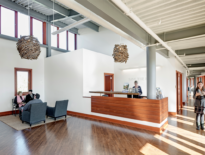State of the Living Building Challenge
Over the past 11 years, thanks to the transformative work of committed groups of owners, developers, and design and construction professionals, the Living Building Challenge has catalyzed regional change with each and every new project. As more and more visitors to certified projects are exposed to the concept and reality of regenerative design, the volume of inquiries ILFI staff receives has increased to a steady hum. The questions are harder to answer these days, too, as the industry has familiarized itself with program requirements and project case studies. Major design firms and contractors, and a lot of smaller firms besides, are building their internal capacity to deliver LBC projects to clients. Design schools teach the framework; ILFI staff members routinely field requests for education and resources from university professors. The next generation of designers to enter the workforce is ready, willing, and hungry for the opportunity to work on an LBC project. As a whole, the industry is poised to deliver a proliferation of Living Buildings.
Meanwhile, in a warming, crowded world, a growing number of large businesses are strengthening their commitment to sustainability. One meaningful, highly visible way that businesses are choosing to demonstrate their sustainability chops is by greening their real estate portfolio. This isn’t purely altruism, of course. Millennials, as a generation, make up the largest proportion of the labor force: More than one in three workers in the United States today are millennials. As a group, these workers are defined in part by their desire to work for mission-driven organizations that are making positive change in the world. An investment in sustainability is therefore an investment in employee attraction and retention, and smart companies are taking note. Some of the most influential and profitable companies in the history of the world are choosing to pursue the Living Building Challenge because they know that it is the most rigorous standard of sustainability for the built environment, and because they are attracted to the credibility conferred upon the certification by its requirement for proven performance and by its third-party audit process.
Companies such as Google, Microsoft, and Etsy, as well as other globally recognized brands that have requested confidentiality, pursue the Living Building Challenge to differentiate themselves from their competitors. Beyond that, these companies pursue the Living Building Challenge to demonstrate that they prioritize the health and well-being of their employees. Etsy’s Petal Certified new headquarters in Brooklyn is a shining example of setting a new standard that creates a space healthy and creative space that is rooted in craft. Google’s new Petal Certified office in Chicago challenges the boundaries of conventional sustainable design and provides a healthy environment for employees.
These companies are not alone, of course. They join a growing cohort of nearly 400 registered projects, 74 of which are certified. These projects run the gamut from small, single-family homes to environmental centers to large industrial, commercial, or institutional buildings. The diversity of owner-types is impressive as well. Some Living Buildings are owned by individuals, while others are owned by nonprofits, foundations, government agencies, or corporations. Even speculative developers are jumping on board.
The recent attraction of the Living Building Challenge to spec developers can, in part, be attributed to incentive programs like Seattle’s Living Building Pilot Program. Pursue the LBC, and you get an extra 10 to 20 feet of building height above zone restrictions, and a density bonus besides. That translates into more leasable square footage, which is often enough to make the pro forma pencil. ILFI’s policy team is hard at work exporting this concept to other cities, and we would benefit from local advocacy. Reach out if you’d like to help!
As Living Buildings take root around the world, ILFI staff are having conversations with a wide diversity of project types in a variety of different contexts and climate zones. Over the years, some themes have emerged. Notably, one recurring topic is that the LBC is impossible to achieve for some building types. Hospitals, for instance, are very energy intensive, and efficiency only goes so far for critical care facilities that require around-the-clock lighting and climate control as well as all manner of medical equipment. It’s not unheard of for hospitals to have energy use intensities of more than 1,000 kBTU/sf/yr. For purposes of comparison, that’s more than 10 times as energy intensive as an average commercial building in the United States, and more than 60 times as energy intensive as the Bullitt Center, a certified Living Building in Seattle, Washington. Other buildings, such as high-rise offices—and especially those in arid regions—simply don’t have sufficient roof area, relative to their leasable square footage, to harvest all of their water needs on site. In many cases, such buildings are sited on contaminated or inaccessible aquifers, precluding their ability to use groundwater to account for their demand.
It serves no broader sustainability purpose to exclude such projects from pursuing the Living Building Challenge. In order for the Living Building Challenge to remain accessible to all buildings, at all scales, in all places, ILFI has recently released two new exceptions. The first, pertaining to energy, is the Off-Site Renewables Exception. This exception allows certain project types, under certain conditions, to locate renewable generation infrastructure off site. Buildings pursuing this path must still incorporate industry-leading efficiency measures, but there is now a path forward for even projects such as data centers. The second exception, pertaining to water, is the Municipal Source Offset Exception. This exception is available to projects that, after maximizing both on-site water capture and implementing best-in-class efficiency, are simply unable to meet the Water Petal. Such projects may connect to the municipal water supply, but they must also offset any water they draw from that supply by introducing efficiency measures in neighboring buildings. In this manner, the project still results in a net reduction in demand from the municipal supply.
It’s safe to say that the Living Building Challenge has reached a new stage in its evolution. An ever-growing number of design and construction firms stand ready to deliver world-class Living Buildings. Clients of all stripes are demonstrating their appetite to build the world’s most sustainable buildings, enhancing their communities, their cities, and—not for nothing—their reputations in the process. And for its part, ILFI is working to accommodate new project types without sacrificing the rigor of its sustainability requirements or deviating from the essential philosophy of the program. The built environment is ripe for change. We invite you to join the Living Future community, and to help create a future that is socially just, culturally rich, and ecologically restorative. There’s strength in numbers, and we can’t do it alone.


